|
 Nederlands /
Dutch Nederlands /
Dutch
Snout moths and grass moths in the garden
Subpage butterflies
and moths:
Butterflies
Owlet
moths, Noctuidae, Geometer
moths Leafrollers,
tortrix moths Concealer
moths, Oecophoridae
Moths
That
moths fly at
night is understandable. Nevertheless
there are about hundred
species, which fly by day and sometimes
they also are beautiful
coloured.
A characteristic of moths are the long feelers,
or antennae,
which
are
unclubbed at the end.
They are often comb-like,
feathery or filamentous.
Most
moths have no bright colours (brown, grey, white or black) and often with
patterns of which help camouflage them during the day.
Moths
tend to have stout and hairy bodies to conserve heat during the cooler nights.
There’s a coupling of the forewing with the hindwing. Unlike
moths, butterflies generally hold their wings together above their backs when
resting.
|
Snout moths, Pyralid Moths (Pyralidae).
They are quite variable in appearance. But all these moths have visible
antennae, when they are in rest. The antennae of other moths are under the
wings. There are some subfamilies. Subfamily
grass moths (Crambidae) is also treated as a full family.
Wikipedia: The principal difference is a structure in the ears called the praecinctorium,
which joins two tympanic membranes in the Crambidae, and is absent from the
Pyralidae.
|
Pyralid Moths (Pyralidae).
Subfamily Galleriinae.
 .. ..
 Bee Moth (Aphomia sociella). Tribe Tirathabini. Subfamily Galleriinae. Family Snout moths, Pyralid Moths (Pyralidae).
Bee Moth (Aphomia sociella). Tribe Tirathabini. Subfamily Galleriinae. Family Snout moths, Pyralid Moths (Pyralidae).
Males have a cream white wing base of the forewing. The forewing of the female has a brown green base colour. The females have a snout that protrudes.
Wingspan about 30 mm.
The larvae live primarily in the nests of bumblebees, but also in the nests of bees and wasps. They eat the wax in these nests. Sometimes the whole nest is eaten. They can also gnaw the wood birdhouses. Beekeepers are not so happy with them.
In autumn, the larvae mature and overwinter in cocoons. Often a number of cocoons are spun against each other.
June-August. Photo 10-7-2010. German: Hummelnestmotte, Hummel-Wachsmotte, Hummelmotte.
 Female 2-8-2013.
Female 2-8-2013. |
 .. ..
 Greater wax moth, honeycomb mot (Galleria mellonella). Tribe Tirathabini. Subfamily Galleriinae. Family Snout moths, Pyralid Moths (Pyralidae).
Greater wax moth, honeycomb mot (Galleria mellonella). Tribe Tirathabini. Subfamily Galleriinae. Family Snout moths, Pyralid Moths (Pyralidae).
A brown-grey moth.
Wingspan about 30-41 mm.
The larvae live in beehives and eat the wax, but also honey, pollinate and skin of hatched bee larvae. They make tunnels covered with silk. The wood of the bee nests can also be damaged. They are found less often in bumblebee nests and wasps nests. May-October.
The caterpillar also eats polyethylene (plastic) !.
Now worldwide. Photos 22-8-2018. German: Große Wachsmotte. French: Fausse teigne de la
cire. |
Subfamily Phycitinae.
 Grey Knot-horn (Acrobasis advenella). Tribe
Phycitini. Subfamily Phycitinae. Family Snout moths, Pyralid Moths (Pyralidae).
Grey Knot-horn (Acrobasis advenella). Tribe
Phycitini. Subfamily Phycitinae. Family Snout moths, Pyralid Moths (Pyralidae).
Grey and red bands on the forewings.
Host plants: Hawthorn, pear.
Wingspan 17-24 mm. July-August. Photo 26-8-2019. |
 .. ..
 Tabby Knot-horn, Ash-bark Knot-horn (Euzophera pinguis). Tribe Phycitini. Subfamily Phycitinae. Family Snout moths, Pyralid Moths (Pyralidae).
Tabby Knot-horn, Ash-bark Knot-horn (Euzophera pinguis). Tribe Phycitini. Subfamily Phycitinae. Family Snout moths, Pyralid Moths (Pyralidae).
On the wings it has pale and dark zigzag lines and bands.
The larvae live under the bark of a living ash. If present in numbers they can eventually kill the tree.
Wingspan 23-28 mm. July-August. Photos 23-8-2013. |
 .. ..
 Phycita roborella. Tribe Phycitini. Subfamily Phycitinae. Family Snout moths, Pyralid Moths (Pyralidae).
Phycita roborella. Tribe Phycitini. Subfamily Phycitinae. Family Snout moths, Pyralid Moths (Pyralidae).
On the forewings a pattern of red, black and greyp.
Wingspan 24-29 mm. Host: Oak, but also pear and apple. The caterpillar spins leaves together with silk.
June-September. One generation. The pupa overwinterts on the ground between leaf-litter or in the earth. Photos 2-8-2013. |
 Phycitodes binaevella. Tribe Phycitini. Subfamily Phycitinae. Family Snout moths, Pyralid Moths (Pyralidae).
Phycitodes binaevella. Tribe Phycitini. Subfamily Phycitinae. Family Snout moths, Pyralid Moths (Pyralidae).
The forewings are black spots on a pale ground colour.
Wingspan 18-26 mm.
Host plants: Spear Thistle, asters, tansy, mugwort. (In the flower heads) The caterpillar
overwinters. June-August. One generation. Europe, Asia Minor. Photo 9-6-2014. |
 .. ..
 . .
 Phycitodes
saxicola. Tribe Phycitini. Subfamily Phycitinae. Family Snout moths, Pyralid Moths (Pyralidae). Phycitodes
saxicola. Tribe Phycitini. Subfamily Phycitinae. Family Snout moths, Pyralid Moths (Pyralidae).
Not entirely sure because of the big resemblance to the Phycitodes maritima. It also looks like Phycitodes binaevella, but is smaller. Difference with Phycitodes martima is. that the whitish part along the leading edge is forked by a dark wedge between the two posterior dots. Furthermore, the ground colour is somewhat darker and the dots smaller. Only very small differences.
Wingspan 12-19 mm.
Host plants: Spear thistle, asters, tansy, mugwort. (In the flower heads) The mature caterpillar
overwinters.
June-August. One generation. In the Netherlands it is rare and only occurs along the coast. Europe. Photos 18-8-2018. |
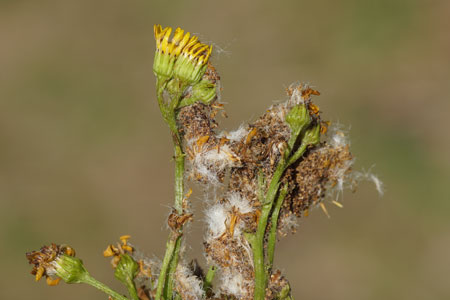 .. ..
 . .
 Phycitodes caterpillar. Tribe Phycitini. Subfamily
Phycitinae. Family Snout moths, Pyralid Moths (Pyralidae).
Phycitodes caterpillar. Tribe Phycitini. Subfamily
Phycitinae. Family Snout moths, Pyralid Moths (Pyralidae).
I have had ragwort - Jacobaea vulgaris in the garden for years. But had never seen this before. There were caterpillars inside. After some searching I came across Phycitodes. However, different species are found on ragwort. The caterpillar of Phycitodes saxicola has stripes according to ukmoths. Then Phycitodes maritima is more likely. See
https://www.ukmoths.org.uk/
But the rare Phycitodes albatella is also found on ragwort. Photos 12-7-2023. |
Subfamily Pyralinae.
Tribe Endotrichini.
 .. ..
 Rose-flounced tabby, Rosy Tabby (Endotricha flammealis). Tribe Endotrichini. Subfamily Pyralinae. Family Snout moths, Pyralid Moths (Pyralidae).
Rose-flounced tabby, Rosy Tabby (Endotricha flammealis). Tribe Endotrichini. Subfamily Pyralinae. Family Snout moths, Pyralid Moths (Pyralidae).
The colour of the wings is variable: ocher, orange-red, dark purple to dark brown
The larvae can be found on different plants, trees. For example, willow and oak.
Wingspan of 18-23 millimeters. June-August. Europe, North Africa. Photos 4-7-2014. |
Tribe Pyralini.
 Small Tabby (Aglossa caprealis). Tribe Pyralini. Subfamily
Pyralinae. Family Snout moths, Pyralid Moths (Pyralidae).
Small Tabby (Aglossa caprealis). Tribe Pyralini. Subfamily
Pyralinae. Family Snout moths, Pyralid Moths (Pyralidae).
A light zigzag band over the wings. They can be found in barns, stables, haystacks, etc. The caterpillar can be found on dead and rotting vegetable matter. For example straw, grain, but also decomposing animal material.
Overwinters as a pupa.
Wingspan 23-27 mm. June-August It occurs worldwide. Photo 8-8-2020. |
 .. ..  Large Tabby (Aglossa pinguinalis). Tribe Pyralini. Subfamily Pyralinae. Family Snout moths, Pyralid Moths (Pyralidae).
Large Tabby (Aglossa pinguinalis). Tribe Pyralini. Subfamily Pyralinae. Family Snout moths, Pyralid Moths (Pyralidae).
The female is darker than the male.
They are found in barns, stables etc. The caterpillar can be found on dead and decaying vegetable matter. Like straw, grain, but also dung. The caterpillar overwinters.
Wingspan 30-40 mm. June-September. Worldwide. Photos 26-6-2012,14-7-2015. |
 .. ..

 Hypsopygia glaucinalis. Tribe Pyralini. Subfamily Pyralinae. Family Snout moths, Pyralid Moths (Pyralidae).
Hypsopygia glaucinalis. Tribe Pyralini. Subfamily Pyralinae. Family Snout moths, Pyralid Moths (Pyralidae).
The forewings are dark brown with two pale, thin transverse lines
The caterpillars feed on decaying plant debris.
Wingspan of 23-31 millimeters. June-October. Europe, North Africa, Asia Minor. Photos 18-7-2014.
|
 .. ..
 Meal Moth (Pyralis farinalis). Tribe
Pyralini. Subfamily Pyralinae. Family Snout moths, Pyralid Moths (Pyralidae). Meal Moth (Pyralis farinalis). Tribe
Pyralini. Subfamily Pyralinae. Family Snout moths, Pyralid Moths (Pyralidae).
Like on the photo, the meal moths rest characteristically with the tip of the abdomen curved up at right-angles to the body. This moth I had found at home. Here it did not stay long, for it was not such a safe place.
The caterpillars feed on stored grain (products) Of course not everyone is happy about that.
Wingspan: 18-30 millimeters. June to August. Several generations. It is widespread worldwide. Photos 11-7-2008, 9-8-2913. German: Mehlzünsler. |
Grass moths (Crambidae)
Subfamily Crambinae
 Straw Grass-veneer (Agriphila straminella). Subfamily
Crambinae. Family grass moths (Crambidae).
Straw Grass-veneer (Agriphila straminella). Subfamily
Crambinae. Family grass moths (Crambidae).
Elongated, from straw yellow to dark brown. Dark dots along the wing edge.
The caterpillar can be found on various types of grass, in particular needle
sheep's fescue (Festuca ovina). June-September. The caterpillar hibernates.
Wingspan 16-20 mm. Europe, Asia. Photo 11-7-2020. |
 Agriphila
tristella. Subfamily Crambinae. Family grass moths (Crambidae). Agriphila
tristella. Subfamily Crambinae. Family grass moths (Crambidae).
Oblong with a light stripe on the wings.
The caterpillar are found on different grasses. They live in the base of the stems of grass.
June to September. Wingspan 22-30 mm. Europe and western Asia. Photo 15-8-2010.
|
 .. ..
 Chrysoteuchia culmella. Subfamily Crambinae. Family grass moths
(Crambidae).
Chrysoteuchia culmella. Subfamily Crambinae. Family grass moths
(Crambidae).
Oblong with one or two angled cross-lines on the forewings and with metallic golden fringe.
The caterpillar are found on different grasses. They live in the base of the stems of grass. June-July. The caterpillar hibernates in a cocoon..
Wingspan 18-24 mm. Europe. Photos 5-7-2014. |
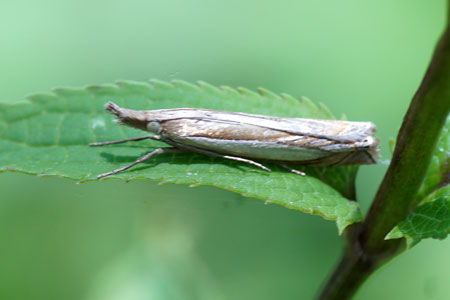 Crambus pascuella. Subfamily Crambinae. Family grass moths
(Crambidae).
Crambus pascuella. Subfamily Crambinae. Family grass moths
(Crambidae).
Elongated with a broad, glossy white median longitudinal stripe on the forewings, narrowing towards the rear, surrounded by a silvery white stripe. A white dorsal stripe.
The caterpillar can be found on various grass species. The caterpillar overwinters..
Spanwijdte 20-24 mm. Europa. Foto's 6-7-2025. |
Subfamily Evergestinae.
 .. ..
 Evergestis extimalis. Subfamily Evergestinae. Family grass moths
(Crambidae).
Evergestis extimalis. Subfamily Evergestinae. Family grass moths
(Crambidae).
The forewings are whitish brown, yellow. On the two brown wavy transverse lines are dark brown points. The transverse lines are not visible at this grass moth.
The caterpillars feed on plants of the cabbage family.
Wingspan: 27-31 mm. June-August One generation. In Southern Europe they fly longer in two generations, the caterpillar overwinters. Europe, Asia. Photos 29-7-2014. |
 .. ..
 Garden Pebble (Evergestis forficalis). Subfamily Evergestinae. Family grass moths
(Crambidae). Garden Pebble (Evergestis forficalis). Subfamily Evergestinae. Family grass moths
(Crambidae).
The front wings are ocher and brown. They also have a large number of slightly curved or wavy transverse lines. The hind wings are whitish. It looks like the straw dot
(Rivula sericealis).
The caterpillars feed on plants of the cabbage family.
Wingspan: 28-33 mm. May-September Two generations. The caterpillar overwinters in a cocoon. Europe, Asia, North America. Photos 21-5-2014. German: Kohlzünsler.
|
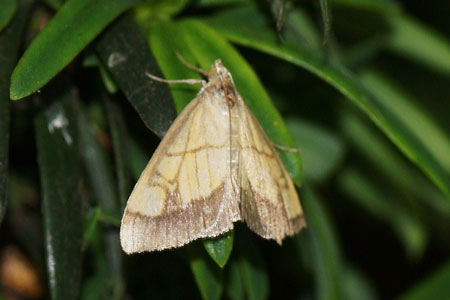 .. ..  . .  . .  Evergestis
limbata. Subfamily Evergestinae. Family grass moths (Crambidae). Evergestis
limbata. Subfamily Evergestinae. Family grass moths (Crambidae).
The forewings are light brown with dark veins. This moth was on a dark spot in the yew.
The caterpillars feed on plants of the the crucifers or the cabbage family, especially Garlic mustard and hedge mustard.
They were mainly found in southern Europe, but they are spreading more and more to the north.
Wingspan: 20-23 mm. May-September. Two generations. Europe. Photo 29-7-2012, 7-7-2013, 13-6-2014. |
Subfamilie Nymphulinae.
 .. ..
 Small China-mark (Cataclysta lemnata). Subfamily Nymphulinae. Family grass moths
(Crambidae).
Small China-mark (Cataclysta lemnata). Subfamily Nymphulinae. Family grass moths
(Crambidae).
The wings of the males are white. The females have golden brown markings. The hind wings have a row of black spots parallel to the wing edge.
The smaller man is flying at the end of the afternoon over the pond. The female flies at night.
The host plant of the caterpillars is Duckweed (Lemna spp.). The caterpillars lives in cases of fragments of the duckweed just below the water surface. These cases contain air to breath.
I am happy with this moth, because there is still too much duckweed in the pond.
Wingspan: 18-24 mm.
May-August. Europe. Photos 15-8-2012, 13-8-2012.
 Female 2-7-2013. Female 2-7-2013.
 Case of fragments of the duckweed. 11-6-2014.
Case of fragments of the duckweed. 11-6-2014. |
Subfamily Pyraustinae.
 Elderberry pearl, elder pearl, crowned phlyctaenia (Anania coronata). Subfamily
Pyraustinae. Family grass moths (Crambidae).
Elderberry pearl, elder pearl, crowned phlyctaenia (Anania coronata). Subfamily
Pyraustinae. Family grass moths (Crambidae).
Wingspan 23-26 mm.
Dark brown wings. Light circular spots and are slightly fringed.
The caterpillar feeds on elderberry, ash, bindweed, sunflower, privet, snowball and lilac. It overwinters as a caterpillar.
Flies in: June and July. Europe. East Asia (Russian Far East). Introduced in North America..
Photo: 3-7-2023. |
 .. ..
 Small Magpie (Anania hortulata, formely: Eurrhypara
hortulata). Subfamily Pyraustinae. Family grass moths (Crambidae).
Small Magpie (Anania hortulata, formely: Eurrhypara
hortulata). Subfamily Pyraustinae. Family grass moths (Crambidae).
Although it is also a day-flying moth from the family Crambidae, the Small Magpie flies especially in twilight and also at night.
It is larger than the Mint moth. The wingspan is 24-28 mm.
White wings with dark spots with some yellow body parts.
You can find the butterfly especially in the nettle. Here it is in a yew.
The caterpillar feed on of woundwort and nettle. (but also other plants) It feeds from a rolled or spun leaf in August and September It hibernates as a cocoon.
It flies in June and July.
West Europe, East Asia. Photo left: 8-6-2012. German: Brennnesselzünsler. |
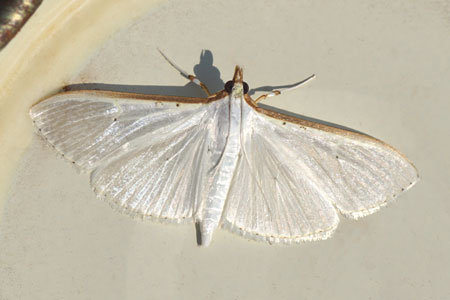 Jasmine moth (Palpita vitrealis).
Subfamily Pyraustinae. Family grass moths (Crambidae).
Jasmine moth (Palpita vitrealis).
Subfamily Pyraustinae. Family grass moths (Crambidae).
A white, glossy moth. The forewings with a dark border at the front. The caterpillars live on shrubs like jasmine
(Jasminum officinale), olive (Olea), lliguster (Ligustrum).
Wingspan: 27-31 mm.
July-October. One generation. Worldwide. Photos 27-8-2019. |
 .. ..
 . .
 Mother of Pearl (Pleuroptya ruralis). Subfamily Pyraustinae. Family grass moths (Crambidae). Sometimes you can read as family: Snout moths, Pyralid Moths (Pyralidae). Mother of Pearl (Pleuroptya ruralis). Subfamily Pyraustinae. Family grass moths (Crambidae). Sometimes you can read as family: Snout moths, Pyralid Moths (Pyralidae).
In the light they sometimes have a pearly glow. (the picture left). It is a day active moth. This moth a saw, when I was watering the garden.
The caterpillars feed on nettles. They roll up a nettle leaf and fix it with silk. Here they hibernate. They are sometimes on other plants.
Wingspan: 26-40 mm. That's large for a grass moth.
May-September Two generations. Photo 11-7-2011. German: Nesselzünsler. French: Pyrale du
Houblon. |
 .. ..
 . .
 Mint moth (Pyrausta aurata) is a day-flying moth. Subfamily Pyraustinae. Family grass moths (Crambidae). Mint moth (Pyrausta aurata) is a day-flying moth. Subfamily Pyraustinae. Family grass moths (Crambidae).
It is small moth and its food plant is mint (how it is possible with such a name) but also species such as marjoram
On the photo it sits however on Green Alkanet, Evergreen Bugloss (Pentaglottis sempervirens) If it rests the feelers lie on its back.
The Mint moth has a gold spot on the forewing. Its the related to the Purprmott (Pyrausta purpuralis) (more spots).
The larvae of the autumn generation hibernate in their cocoons.
Flying time: April-September. Two generations. Wingspan 10-15 mm. In north-west Europe. Purpurzünsler: French: Pyrale de la menthe.
5 July I saw a damaged mint moth with a fly on a Thousand-leaf, Yarrow. The feelers stand up now. |
 Straw-barred Pearl (Pyrausta despicata). Subfamily Pyraustinae. Family grass moths
(Crambidae). Not in the garden but in the dunes about 3 km from our house. Straw-barred Pearl (Pyrausta despicata). Subfamily Pyraustinae. Family grass moths
(Crambidae). Not in the garden but in the dunes about 3 km from our house.
The colour and markings of the forewing are highly variable, ranging from olive-gray to blackish brown. The moths are active at dusk and at night.
The caterpillars are found on different species of ribwort like ribwort plantain and plantago major at the base of the leaves in a cocoon. The caterpillar overwinters in a cocoon.
Flying time May-September. Two generations.
Wingspan 14-20 mm. Europe, Asia Minor. Photo 23-8-2012. German: Olivbraune Zünsler, Olivenbraune Zünsler.
 8-7-2023. Eleven years later, a Pyrausta despicata for the first time in our greenhouse.
8-7-2023. Eleven years later, a Pyrausta despicata for the first time in our greenhouse.
|
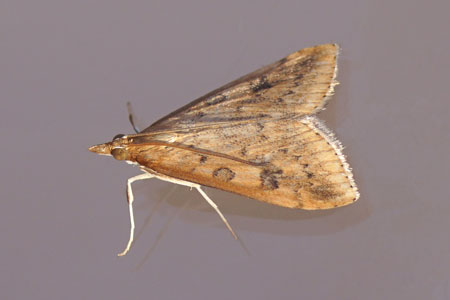 Rusty dot pearl (Udea ferrugalis). Subfamily
Pyraustinae. Family grass moths (Crambidae).
Rusty dot pearl (Udea ferrugalis). Subfamily
Pyraustinae. Family grass moths (Crambidae).
It flies at night. It is no day-flying moth like the other members of this family on this page.
Resembles Udea fulvalis, but with a goldish glow on the wings and black markings on the forewing. White legs.
The caterpillars can be found in herbaceous plants, such as Stachys, Eupatorium.
Flight time: All year round, especially in autumn. One generation. Wingspan 18-22 mm. Africa and Europe, In the Netherlands a migratory butterfly that can only hibernate in mild winters.
Photo 17-11-2023. |
 .. ..
 Udea prunalis. Subfamily Pyraustinae. Family grass moths
(Crambidae). Udea prunalis. Subfamily Pyraustinae. Family grass moths
(Crambidae).
It flies at night. It is no day-flying moth like the other members of this family on this page.
It is recognized by the line at the bottom of the wing. Above the line there are two dark dots. The lower dot is larger. The colour is light gray brown with white legs and body.
The larvae feed on the leaves of a wide range plants, trees, shrubs.
The young caterpillar hibernates in a cocoon on a leaf. Flying time June - August. One generation.
Wingspan 23-26 mm. Photos 8-8-2009, 4-6-2012. |
Subfamily Scopariinae.
 Little Grey (Eudonia lacustrata). Subfamily
Scopariinae. Family grass moths (Crambidae).
Little Grey (Eudonia lacustrata). Subfamily
Scopariinae. Family grass moths (Crambidae).
The drawing looks like that of granite. It looks like the Scoparia species and Eudonia species.
The caterpillars can be found on mosses.
May-August. One generation. Wingspan 16-18 mm. Europe, Northwest Africa, Asia.
Photo 27-6-2023. |
 .. ..
 Eudonia mercurella. Subfamily Scopariinae. Family grass moths
(Crambidae).
Eudonia mercurella. Subfamily Scopariinae. Family grass moths
(Crambidae).
The drawing looks like that of granite. It looks like the Scoparia species and some Eudonia species. The two images are of different kinds.
The caterpillars can be found on mosses. It hibernates as a caterpillar.
June-September. One generation. Wingspan 16-19 mm. Europe, North Africa, Asia. Photos 5-7-2014. |
 .. ..
 Scoparia ambigualis. Subfamily Scopariinae. Family grass moths
(Crambidae).
Scoparia ambigualis. Subfamily Scopariinae. Family grass moths
(Crambidae).
The drawing looks like that of granite. (Dutch name is granite moth) It's a common moth in the Netherlands. There are three similar moths of the genus Scoparia in the Netherlands: The rare Scoparia basistrigalis and Scoparia pyralella and the very rare Scoparia subfusca.
The caterpillars feed on mosses. May-August. Wingspan 15-22 mm. Photos 15-7-2013. |
Subfamily Spilomelinae.
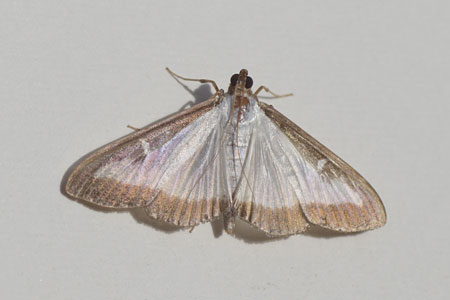 .. ..
 . .
 Box tree moth (Cydalima
perspectalis). Subfamily Spilomelinae. Family grass moths
(Crambidae).
Box tree moth (Cydalima
perspectalis). Subfamily Spilomelinae. Family grass moths
(Crambidae).
A white moth with a dark edge around the wings and white spot. Therefore easy to recognize. But sometimes completely dark with white spot.
The caterpillar feeds on box, when the box recovers, it suffers damage by the next generation of caterpillars. The caterpillars are nowadays eaten by different birds (so do not use poison). As a result, there is a chance that there will be a little more balance and the damage to the box maybe will reduced in future.
April, May-September. Two or three generations. The half-grown caterpillar overwinters.
Wingspan 40-45 mm. Native to East Asia (Japan, South Korea, China). Introduced in Europe through the host plant buxus, it is an invasive exotic moth. First observations in the Netherlands in 2007. Photos
18-8-2018, 17-9-2020, 24-7-2023. . German: Buchsbaumzünsler. French: La Pyrale du
buis. |
On waarneming: All
Pyralidae of the Netherlands and All
Crambidae of the Netherlands
Nederlands /
Dutch
 
Subpage France:
Insects
France
Subpage butterflies
and moths:
Butterflies
Owlet
moths, Noctuidae
Geometer
moths
Leafrollers,
tortrix moths
Concealer
moths, Oecophoridae
|
